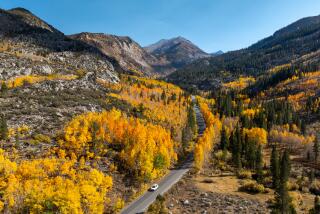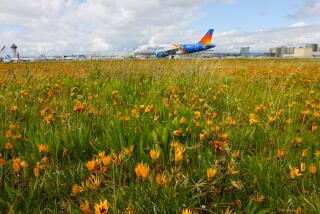For the allergic, leaf-peeping may not be a walk in the park
- Share via
Fall foliage tours give Californians a chance to ooh and aah over nature’s colorful performance in other parts of the country. You can bike, hike, drive or be driven through autumn’s brilliance.
But if you’re the allergic type, you can end up achooing your way through the woods. It pays to do some additional groundwork before departure.
Pollens vary by season and region, says Dr. Ricardo Tan, a Los Angeles allergist and member of the executive committee of the California Society of Allergy, Asthma and Immunology.
“In the fall it is mostly weeds that pollinate, depending on [the] area of the U.S.,” he says. “There are also trees and grasses that pollinate.”
If you’re headed for Massachusetts now through October, ragweed and sagebrush, both weed pollens, will likely be plentiful, says Dr. Wil Beaucher, an allergist in that state. In April, willow, maple and ash tree pollens are plentiful. In May, oak and birch pollens are prevalent. But by June and July, grass pollens predominate, he says.
Before departure you can check pollen reports at your destination. Two resources are the American Academy of Allergy, Asthma and Immunology’s National Allergy Bureau Pollen and Mold Report, www.aaaai.org/nab, and Pollen.com, a Pennsylvania-based company that posts nationwide pollen conditions at www.pollen.com.
If you aren’t sure about the specifics of your allergies, ask your doctor about skin tests that determine which common trees, leaves, grasses and weeds you’re sensitive to. For those of you who already know about your allergies and are on medication, Tan and Beaucher suggest asking your doctor whether those medications should be adjusted.
Tan says people who react to pollen usually are prescribed an antihistamine such as Allegra (fexofenadine HCl), Clarinex (desloratadine) or Zyrtec (cetirizine HCl). He might add a nasal spray such as Flonase (fluticasone propionate) or Nasacort (triamcinolone acetonide) to be used as needed.
Patients traveling to a place where pollen exposure is high should use the spray regularly, Tan says, and they should start early because the drug may need a day or two to take effect.
Changes in barometric pressure also can cause or aggravate nasal congestion, blocking and inflaming sinuses, Tan says, adding, “or the plane ride can do it.” He sometimes prescribes a decongestant plus an antihistamine, such as Allegra-D (fexofenadine and pseudoephedrine).
“The antihistamine will take care of the allergy, and the decongestant helps keep the passages clear during the plane trip,” Tan says.
If the reaction seems mild, self-treatment is an option.
“The safest is to use Claritin [loratadine] over the counter and also NasalCrom spray [cromolyn sodium],” Beaucher says, adding that Opcon-A (naphazoline hydrochloride, pheniramine maleate) is one choice for over-the-counter eyedrops.
If you start wheezing or have difficulty breathing, go to a walk-in clinic or emergency department, Beaucher says. That’s especially important for people with asthma, because allergic reactions to pollen can precipitate an asthma attack.
The scheduling of sightseeing also can be important.
“Pollens are always released in the early morning hours,” Beaucher says, “so that is the time we recommend people sleep with the windows closed, or keep the air conditioner on with the vent closed in a hotel.” If you’re in a car, he says, leave the air conditioner on with the vents set to recirculate air. Save sightseeing for later in the day.
Healthy Traveler appears every other week. Kathleen Doheny can be reached at kathleendoheny@earthlink.net.
More to Read
Sign up for The Wild
We’ll help you find the best places to hike, bike and run, as well as the perfect silent spots for meditation and yoga.
You may occasionally receive promotional content from the Los Angeles Times.






